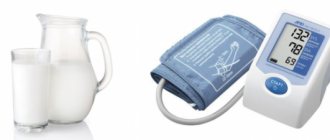08.12.2017
Last modified: March 21, 2021 at 10:52 am
Blood pressure indicators deviate from normal under the influence of external causes and internal pathologies. One such factor is blood sugar: increased sugar increases blood pressure.
A separate range of issues is related to the mutual influence on the human body of chronic diseases, which are characterized by increased levels of sugar and blood pressure - diabetes and hypertension.
Why does the body need sugar and its blood levels?
Maintaining vital functions requires the presence of sugar in the food system, and in a certain amount. The product, when consumed in moderation, reduces the likelihood of atherosclerosis, thrombosis and arthritis, and stimulates the functions of the spleen and liver.
Sugar in the body is present in the form of a monosaccharide - glucose, which participates in all metabolic processes, playing the role of an energy supplier. Sugar levels, or more correctly, indicators of glucose concentration in the blood, are called glycemia. Accordingly, an excess of the normal level is hyperglycemia, a decrease in concentration below the norm is hypoglycemia.
A temporary drop in blood sugar can be caused by:
- diseases in acute and chronic form;
- physical or nervous stress;
- food low in carbohydrates;
- significant dietary disturbances.
As a result of hypoglycemia, a deterioration in well-being occurs, including loss of consciousness and coma. Constant relapses indicate a disruption in the functioning of the kidneys, adrenal glands, hypothalamus, and pancreas.
A one-time excess of sugar levels (hyperglycemia) may be associated with increased stress, including emotional stress, abuse of sweets and be temporary. To a mild degree, such deviations are not dangerous and pass quickly. Repeated diagnosis of excess glucose concentration in the blood indicates the presence of an endocrine disease:
- diabetes;
- hyperfunction of the thyroid gland;
- hypothalamic dysfunction;
- malfunction of the liver and pituitary gland.
In this case, hyperglycemia leads to metabolic disorders, decreased immunity, damage to blood vessels and tissues, internal organs, and death.
A blood test is performed to determine the concentration of glucose in the blood. The result is expressed in units: mol/l. The standards depend on the method of blood sampling, are determined by the patient’s age, and are also related to food intake. When taking material on an empty stomach from a finger (capillary blood) in an adult, the norm is considered to be an interval from 3.2 to 5.5 (mmol/l). If an analysis is taken from a vein, the upper limit moves to 6.2 mmol/l.
For elderly and elderly patients, the norm of the lower and upper limits is slightly higher (by about 1 mmol/l).
For newborn babies in the first month of life, the standard is: 2.8-4.4 mmol/l, and for children under 14 years of age it ranges from 3.3 to 5.6 mmol/l.
If the test result taken on an empty stomach is more than 7 mmol/l, the sample is repeated the next day. If high blood sugar levels are confirmed, the patient is at risk for diabetes. He is prescribed a test for glycated (glycosylated) hemoglobin to clarify the diagnosis.
Sugar and blood pressure
The ideal ratio of the upper and lower indicators of the tonometer, characterizing normal blood pressure, is 120 to 80. It is generally accepted that with age there is an increase in blood pressure numbers, at which the patient maintains normal health, and the body systems maintain functional stability. However, when values reach 140 to 90 or higher, arterial hypertension is recorded.
Important information: Diagnosis of hypertension
Elevated blood sugar leads to disruptions in the functioning of many body systems. Hyperglycemia also affects blood pressure, causing an increase in its levels. The relationship between high blood pressure and blood sugar has been confirmed by studies conducted in different countries. Scientists from the State University of Leicester in the UK have found that high blood sugar levels contribute to the narrowing of blood vessels and can increase blood pressure levels, which is not observed at its physiological norm.
An increase in blood pressure is also associated with the formation of plaque on the walls of blood vessels with a constant excess of sugar in the blood, which impedes blood flow due to narrowing of the lumen and provokes hypertension.
High levels of glucose in the blood provoke the release of norepinephrine, disrupt water-salt balance and lipid metabolism, which can increase blood pressure.
In turn, low blood sugar can cause hypotension - a drop in blood pressure below normal. If the condition is accompanied by unpleasant symptoms, weakness and dizziness, hot sweet tea or coffee with candy will help raise blood pressure and improve well-being in emergency cases.
Advice! If you have hypertension, salt should be excluded from the diet, and sugar should be consumed limitedly, about 2-3 spoons in the morning with tea, replacing it in the evening with a glass of kefir.
Is 120/80 already too much?
– In Europe, the figures for optimal blood pressure have been revised. Now the notorious 120/80 is no longer ideal?
– It is important not to confuse the diagnosis and target blood pressure. The new recommendations are not about reconsidering what is considered hypertension, but only about the level of target pressure to which it should be reduced in patients. There has been talk over the past two years that these numbers might need to be revised downward, following the results of the SPRINT study. According to this year's European recommendations, for hypertension it is recommended to reduce blood pressure quite aggressively - below 140/90 mmHg. Art., and if well tolerated - further, but not lower than 120/70 mm Hg. Art. This target pressure should reduce the number of complications and improve the prognosis for patients suffering from arterial hypertension.
But there is no consensus on this matter yet. After all, there cannot be a general target pressure level, since patients are all different - both in age and in the presence/absence of concomitant pathology. However, there are numbers that absolutely everyone should strive for. They relate to the lower, diastolic pressure. It is better to reduce it to 85 mmHg. Art.
But more important, in my opinion, is another European recommendation this year. It concerns the use, at the very beginning of treatment of arterial hypertension, of a combination of drugs from several groups, and not just one drug, as before. Moreover, it is desirable that all these drugs are contained within one tablet. Because the fewer medications a patient takes, the higher his adherence to treatment - and success largely depends on this.
ABC of hypertension. Blood pressure will be reduced in a new way Read more
Diabetes and hypertension
A chronic disease in which blood sugar levels are elevated is diabetes mellitus. The worldwide spread of the disease is comparable to an epidemic. Hypertension is the main symptom of hypertension. Diabetes and hypertension are comorbidities that can interact and increase the risk of complications.
The reasons for changes in pressure in patients with diabetes lie in the characteristics of the types of pathology. There are types 1 and 2 diabetes. Without going into details, it should be noted that in the first case, patients are insulin dependent due to pancreatic dysfunction. In the second case, deterioration in tissue absorption of the hormone insulin produced by this organ leads to hyperglycemia.
A renal pathology that develops in a third of patients with type 1 diabetes, diabetic nephropathy, provokes the development of hypertension. This is due to fluid retention, due to the fact that damaged kidneys can no longer cope with sodium excretion. Excess fluid also provokes hyperglycemia, which can further increase blood pressure.
Kidney function deteriorates, the volume of fluid increases, the constant retention of which in the body is expressed by edema and leads to hypertension.
The opposite situation occurs in a stable hypoglycemic state, if the insulin taken by the patient is not compensated by incoming food and the blood glucose level is low. Against this background, hypotension develops.
Essential hypertension is already present among the risk factors for type 2 diabetes. High blood pressure is a symptom of metabolic syndrome, a complex metabolic disorder caused by tissue resistance to insulin, which leads to the development of type 2 diabetes. Factors that, in turn, increase blood pressure in this type of pathology can be:
- obesity;
- magnesium deficiency;
- stress;
- narrowing of small vessels;
- worsening of atherosclerosis.
High dosages of antihypertensive drugs can provoke hypotension. Adjusting the doses of medications taken, taking into account the characteristics of hypertension in diabetes mellitus, will help raise blood pressure to normal levels. To establish the correct dosage and time of taking antihypertensive drugs, daily monitoring is prescribed.
Important! Blood pressure in diabetes mellitus requires the same constant monitoring as blood sugar levels.
Features of the manifestation of hypertension in diabetes mellitus
High blood sugar and high blood pressure are accompanied by some features that the patient needs to know and the attending physician to take into account.
Important information: Blood pressure 120 over 90: normal or not?
For diabetics, the normalization of blood pressure readings is more stringent; tonometer readings of 130/80 are a guideline, above which they are considered elevated and need to be adjusted with medications or diet.
In hypertensive patients who do not suffer from diabetes, the pressure changes throughout the day, during waking and sleeping hours it is different, and decreases at night by 20-30 units. Hypertension against the background of diabetes mellitus does not show such an effect; moreover, the sleeper’s blood pressure may increase. This is due to nephropathy, which gives complications to the functions of the nervous system, as a result of which the vessels stop responding by contracting and relaxing to rest or stress.
In addition, high blood pressure when lying down is replaced by a sharp decrease when moving to a vertical position. This is how the reduced tone of blood vessels affected by diabetes mellitus manifests itself. May be accompanied by fainting and dizziness. The phenomenon is called orthostatic collapse and is subject to symptomatic treatment.
Important! When diagnosing hypertension and diabetes simultaneously, lowering blood pressure is of paramount importance to improve the general condition and inhibit the development of both pathologies.
Features of treatment
The danger of persistent hypotension, which can develop due to improper therapy, involves a gradual reduction in blood pressure with medications. Medicines are selected taking into account special requirements:
- have no side effects;
- do not affect carbohydrate metabolism;
- has a beneficial effect on the kidneys and heart.
The effect of antihypertensive drugs against the background of metabolic disorders may change, so prescribing adequate treatment for diabetes is not an easy task. It will differ from the treatment of hypertension not burdened by concomitant diseases.
ATP inhibitors are usually preferred. The ability to effectively reduce blood pressure is combined with a protective effect on the kidneys. Drugs in this group must be taken one tablet per day; the most well-known representatives are: Enam, Prestarium, Monopril.
If the drug does not have sufficient effect, a diuretic of the thiazide group is added. A diuretic (Hypothiazide, Indapamide) is recommended to be taken in the morning, every day, the dosage is constant. Not all diuretics are suitable for diabetics.
Attention! Self-medication is unacceptable! Treatment is prescribed by the attending physician, taking into account the results of the examination and tests.
Where to lay the straw?
– There is an opinion that to protect against heart attack and stroke after 40 years, everyone, especially men, should take cardiac aspirin. This is right?
– There is no pill that is ideal for everyone. And if you prescribe aspirin to everyone (without taking into account age or the presence of concomitant diseases), then you can get not benefit, but harm. After all, aspirin increases the risk of internal bleeding and can be dangerous, for example, with peptic ulcers and other diseases. But if the patient already suffers from coronary heart disease or has suffered a myocardial infarction, then the benefits of aspirin are undeniable. But an individual, personalized approach is definitely needed. As doctors of the old school said, it is necessary to treat not the disease, but the patient.
Article on the topic
Cholesterol is no longer harmful: old myths and new facts
– Is it true that low cholesterol does not mean that a person is protected from heart attack and stroke? They used to be afraid of high cholesterol, but now they are saying that it is not a threat...
– Talking about safe cholesterol levels is the same as calculating the average temperature in a hospital. The average approach is only good for statistics. And in life, a person with low cholesterol may have some other risk factors. For example, smoking, physical inactivity or arterial hypertension. And they may well lead to a heart attack. Conversely, high cholesterol may be the only risk factor. In this case, the risk of a heart attack is relatively low. In addition, cardiologists pay attention not to the level of total cholesterol, but to the increase in one of its fractions - LDL (low-density lipoproteins).
Principles of dietary nutrition
Along with drug treatment, a special diet helps to lower blood pressure in a diabetic patient to some extent. A low-carbohydrate diet, developed individually for each patient, is aimed at stabilizing normal glycemia while unloading the pancreas and kidneys, and reducing excess weight.
The general basis of nutritional principles for diabetes to support the kidneys is a reduced amount of salt, sometimes a salt-free diet. Consequently, pickles, sausages, and semi-finished products are excluded. As a rule, sugar is prohibited and replaced with fruits or dried fruits.
A diet is prescribed already in the early stages of the pathology, before protein appears in a urine test. Useful products include:
- white meat rabbit or chicken;
- egg white;
- low-fat cheese;
- sea fish;
- vegetables.
Interesting! Fiber lowers glycemia because our enzymes cannot transform it into glucose. That's why vegetables, especially greens, are so healthy!
A low-carbohydrate diet for a combination of diabetes mellitus and hypertension has no alternative and is the diet of choice in this case, as it allows you to lower both sugar and blood pressure.
And they eat Russian lard!
– Previously, it was believed that only vegetables, fruits, and fish were good for the heart - in general, the Mediterranean diet. But recently, Israeli scientists suddenly rehabilitated salt. And lard doesn’t seem to be so harmful. Has cardiologists' views on cardiac nutrition changed?
- Changed. Recent evidence shows that the consumption of saturated fats (pork, eggs, full-fat milk) is less important for the cardiovascular system than the consumption of easily digestible carbohydrates, especially sugar. Therefore, sweets should be limited first of all. Trans fats are also harmful - processed palm oil, for example. But regarding salt, I absolutely agree with the recommendations of the Ministry of Health, which recognized its excessive consumption as a risk factor for cardiovascular diseases. And our European colleagues are of the same opinion.
However, the fact that fatty foods have been recognized as less dangerous than before does not mean that you can eat as much of it as you like. After all, a bathhouse is also useful, but only in moderation, and if you steam for too long, the vessels may not withstand it. Everything requires a reasonable approach.
Surprises of cardiology. Fat does not harm blood vessels, but omega-3 acids are useless Read more
– Many people do not trust medications, but they firmly believe in the benefits of dietary supplements. Is it true that omega-3 fatty acids protect blood vessels from atherosclerosis?
– It has been two years since the results of studies were published showing that pharmacological preparations containing omega-3 acids are completely useless for the prevention of heart and vascular diseases. Nevertheless, those fatty acids found in food (primarily in sea fish) are beneficial for the heart.









